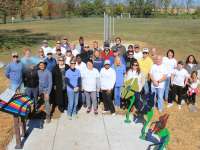To help encourage intergenerational recreation opportunities, we first need to understand the physical environment and how it influences social behavior. Great intergenerational spaces must go beyond “activities and programs” and align the physical environment with the infrastructure needed to open dialogues and encourage gathering in intergenerational settings. Well-planned outdoor environments that remove barriers to participation and give consideration to the preferences, habits, and comfort of a broad collective across the age spectrum can set the stage for a meaningful interface between all people. Layering activity options to broaden intergenerational experiences is important. Lessons can be learned from the publication, Why People Love Where They Live and Why it Matters, and the same factors identified in why people of all ages are attracted to a community can certainly be applied to parks.
No matter what the overall activities, it’s important to think of design considerations that transcend specific pursuits and are applicable to all settings.
Access and Inclusion
It’s critical to think about the abilities of people across a diverse generational span, as people of different ages vary in their physical functioning. Using best practices for inclusive design is a good way to ensure active independence across generations and to ensure physical and social opportunities for all, including those with and without disabilities. Now, more than ever, communities are seeking innovative ways to unite children, families, and communities through the power of play and recreation. Using these inclusive design principles will help to facilitate intergenerational integration in the activities that occur in play and recreation spaces, and help to provide spaces that all can enjoy.
While specific amenities within a space can be designed to be inclusive (i.e. playgrounds, picnic tables), it’s important to think of the overall space design. The US Access Board provides great information (see Resources) but also consider comfort and wayfinding, especially for our oldest generations and the normal biological changes that come with increasing age: reduction in muscle strength; higher levels of fatigue; reductions in agility, coordination, equilibrium, flexibility, joint mobility and increased rigidity in the tendons, and reductions in sensory capacities (hearing and vision.) It’s important to give consideration to well-placed handrails, contrasting color on steps, fall attenuating surfaces, adequate lighting, park maps, route markers, shade, etc. to enable people of all ages and abilities to navigate the overall space comfortably and confidently. Be sure sidewalks are free of wide cracks, holes and trip hazards and that vegetation is not allowed to encroach on walkways. Where possible, consider fall attenuating poured rubber surfaces for primary paths. Provide ample trash receptacles, as carelessly discarded trash can also present trip hazards.
Resting
In addition to benches being added throughout active and passive environments, it’s important to consider benches “along the way,” for those who may need to rest as they walk through the space, especially in larger parks where target amenities may be farther from parking areas than some users are comfortable with. Include benches with high backs and arm rests to make sitting and standing from a seated position easier for those with hip or knee replacements and/or limited mobility. As mentioned previously, don’t forget shade options, especially in warmer climates.
Lighting
A Recent NRPA survey found that 91% of residents who were asked are interested in attending nighttime park activities.68 Make it easier for them by providing good lighting options, minimally from the parking lot to the area where evening events will take place. Evening lighting can also help reduce crime. Harvard Park, in Inglewood, CA was once known for gang conflict at night, making it a less than desirable family destination once the sun set. The launched a program called Summer Night Lights, which not only added lighting to parks, but also programming such as athletics, arts, and family programs. The initiative has resulted in community comfort and increased usage, which has improved the park’s usership and safety.69
Restrooms
Public restrooms are an important amenity in a park. Many people will avoid using a park or revisit it less often if restrooms are either unavailable or inadequate. Providing a restroom for visitors is generally recommended if budget allows. Restrooms should be located near areas that people congregate, so before choosing a location, consider where people are entering, exiting, and gathering. If you have a large park, you may wish to consider multiple smaller restrooms instead of one large one. Locating near existing sewer, water, and electric connections can help save budget on new restrooms.
Parking and Traffic Calming Initiatives
Be sure to consider traffic planning when striving to include all people. Lower income neighborhoods see a disproportionately high number of pedestrian fatalities.70 Older adults and children are also extremely vulnerable to being struck by a motor vehicle due to ambulatory ability and various other contributing factors.71 Pedestrians struck by vehicles traveling at 40 mph die as a result 80 percent of the time. When struck by a vehicle traveling 20 mph, pedestrians survive 90 percent of the time.72 Slower speeds, safe crossings and continuous sidewalks are key ingredients for connecting parks to the people who need them the most.



